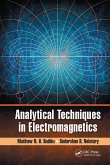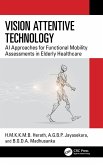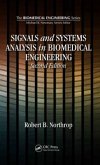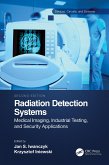Advanced Electroencephalography Analytical Methods
Fundamentals, Acquisition, and Applications
Herausgeber: Naik, Ganesh; Gargiulo, Gaetano; Santos, Wellington Pinheiro Dos
Advanced Electroencephalography Analytical Methods
Fundamentals, Acquisition, and Applications
Herausgeber: Naik, Ganesh; Gargiulo, Gaetano; Santos, Wellington Pinheiro Dos
- Gebundenes Buch
- Merkliste
- Auf die Merkliste
- Bewerten Bewerten
- Teilen
- Produkt teilen
- Produkterinnerung
- Produkterinnerung
This book presents the theoretical basis and applications of electroencephalography (EEG) signals in neuroscience, involving signal analysis, processing, signal acquisition, representation, and applications of EEG signal analysis using non-linear approaches and machine learning.
Andere Kunden interessierten sich auch für
![Algae in the Bioeconomy Algae in the Bioeconomy]() Jean-Luc WertzAlgae in the Bioeconomy165,99 €
Jean-Luc WertzAlgae in the Bioeconomy165,99 €![Analytical Techniques in Electromagnetics Analytical Techniques in Electromagnetics]() Matthew N O SadikuAnalytical Techniques in Electromagnetics183,99 €
Matthew N O SadikuAnalytical Techniques in Electromagnetics183,99 €![Vision Attentive Technology Vision Attentive Technology]() H M K K M B HerathVision Attentive Technology198,99 €
H M K K M B HerathVision Attentive Technology198,99 €![Cognitive Computing for Internet of Medical Things Cognitive Computing for Internet of Medical Things]() Cognitive Computing for Internet of Medical Things152,99 €
Cognitive Computing for Internet of Medical Things152,99 €![Signals and Systems Analysis in Biomedical Engineering Signals and Systems Analysis in Biomedical Engineering]() Robert B NorthropSignals and Systems Analysis in Biomedical Engineering186,99 €
Robert B NorthropSignals and Systems Analysis in Biomedical Engineering186,99 €![Radiation Detection Systems Radiation Detection Systems]() Radiation Detection Systems174,99 €
Radiation Detection Systems174,99 €![Power System Simulation Using Semi-Analytical Methods Power System Simulation Using Semi-Analytical Methods]() Power System Simulation Using Semi-Analytical Methods143,99 €
Power System Simulation Using Semi-Analytical Methods143,99 €-
-
-
This book presents the theoretical basis and applications of electroencephalography (EEG) signals in neuroscience, involving signal analysis, processing, signal acquisition, representation, and applications of EEG signal analysis using non-linear approaches and machine learning.
Hinweis: Dieser Artikel kann nur an eine deutsche Lieferadresse ausgeliefert werden.
Hinweis: Dieser Artikel kann nur an eine deutsche Lieferadresse ausgeliefert werden.
Produktdetails
- Produktdetails
- Verlag: CRC Press
- Seitenzahl: 268
- Erscheinungstermin: 13. Dezember 2024
- Englisch
- Abmessung: 234mm x 156mm x 18mm
- Gewicht: 576g
- ISBN-13: 9781032171708
- ISBN-10: 1032171707
- Artikelnr.: 70975473
- Herstellerkennzeichnung
- Libri GmbH
- Europaallee 1
- 36244 Bad Hersfeld
- gpsr@libri.de
- Verlag: CRC Press
- Seitenzahl: 268
- Erscheinungstermin: 13. Dezember 2024
- Englisch
- Abmessung: 234mm x 156mm x 18mm
- Gewicht: 576g
- ISBN-13: 9781032171708
- ISBN-10: 1032171707
- Artikelnr.: 70975473
- Herstellerkennzeichnung
- Libri GmbH
- Europaallee 1
- 36244 Bad Hersfeld
- gpsr@libri.de
Ganesh Naik, ranked in the top 2% of researchers in Biomedical Engineering (Stanford University Research), is a leading expert in biomedical engineering and signal processing. He received his Ph.D. degree in Electronics Engineering, specializing in biomedical engineering and signal processing, from Royal Melbourne Institute of Technology (RMIT) University, Melbourne, Australia, in December 2009. Currently, he is an academic and research theme co-lead at Flinders University, Adelaide, Australia. He held a Postdoctoral Research Fellow position at MARCS Institute, Western Sydney University (WSU) between July 2017 to July 2020 and worked on a Cooperative Research Centres (CRC) project for sleep. During his tenure at WSU, he has developed several novel algorithms for wearables related to sleep projects. Before that, he held a Chancellor's Post-Doctoral Research Fellowship position in the Centre for Health Technologies, University of Technology Sydney (UTS), between February 2013 and June 2017. As a mid-career researcher, he has edited 12 books and authored around 150 papers in peer-reviewed journals and conferences. Ganesh serves as an associate editor for IEEE Access, Frontiers in Neurorobotics, and two Springer journals (Circuits, Systems, and Signal Processing and Australasian Physical & Engineering Sciences in Medicine). He is a Baden-Württemberg Scholarship recipient from Berufsakademie, Stuttgart, Germany (2006-2007). In 2010, he was awarded an ISSI overseas fellowship from Skilled Institute Victoria, Australia. Wellington Pinheiro dos Santos holds a degree in electrical and electronic engineering (2001) and a master's degree in electrical engineering (2003) from the Federal University of Pernambuco, and a PhD in Electrical Engineering from the Federal University of Campina Grande (2009). He is currently an associate professor (exclusive dedication) at the Department of Biomedical Engineering at the Center for Technology and Geosciences / School of Engineering of Pernambuco, Federal University of Pernambuco, working in the undergraduate program in Biomedical Engineering and the Graduate Program in Biomedical Engineering. He is also a member of the graduate program in computer engineering at Escola Politécnica de Pernambuco, Universidade de Pernambuco, since 2009. He has experience in the field of computer science, with an emphasis on graphics processing, working mainly in the following areas: topics: digital image processing, pattern recognition, computer vision, evolutionary computing, numerical optimization methods, computational intelligence, image formation techniques, virtual reality, game design and applications of computing and engineering in medicine and biology. He is a member of the Brazilian Society of Biomedical Engineering (SBEB), the Brazilian Society of Computational Intelligence (SBIC, ex-SBRN), and the International Federation of Medical and Biological Engineering (IFMBE). Gaetano Gargiulo received his Ph.D. in biomedical engineering from the University of Bologna, Bologna, Italy, in 2010. Currently, he is a research professor at the School of Engineering, Design and Built Environment,Western Sydney University. He also is a Research Affiliate at "Federico II" University of Naples, Naples, Italy. His research interests include medical instrumentation/devices, telemedicine, human-computer interfaces, and bio-inspired systems. He is a coauthor of more than 100 papers in these research areas and has edited four scholarly books in applied biomedical engineering; he is an inventor on 10 patents and contributed to spin out four commercial companies all in the field of biomedical engineering.
1. Diagnostic applications of EEG signal patterns in Neuroscience. 2. Deep
Learning Techniques for Automatic Sleep Pattern Identification and Disorder
Evaluation using EEG Signals. 3. Recent Trends in EEG-Based MI and SSVEP
Brain-Computer Interface Applications - A Review. 4. Recent Trends in
EEG-Based P300, Neuromarketing and E-sports Brain-Computer Interface
Applications - A Review. 5. Significance of Fourier Transform for Epileptic
EEG Signals Analysis. 6. Alternative treatment with nonperiodic acoustic
stimulation for pharmacoresistant epileptic patients: an exploratory study.
7. Artifacts removal in Electroencephalogram (EEG) signals. 8.
Multi-channel and multi-label decision-making system (MCL-DMS) for sleep
stage and sleep disorder recognition from EEG signals. 9. Analyzing and
Decoding Natural Reach & Grasp Action Using Convolutional Neural Network.
10. Classification of motor imagery EEG signals based on sparse
representations of Empirical Mode Decomposition features. 11. Prediction of
Onset of Seizures from EEG signals using ML Techniques.
Learning Techniques for Automatic Sleep Pattern Identification and Disorder
Evaluation using EEG Signals. 3. Recent Trends in EEG-Based MI and SSVEP
Brain-Computer Interface Applications - A Review. 4. Recent Trends in
EEG-Based P300, Neuromarketing and E-sports Brain-Computer Interface
Applications - A Review. 5. Significance of Fourier Transform for Epileptic
EEG Signals Analysis. 6. Alternative treatment with nonperiodic acoustic
stimulation for pharmacoresistant epileptic patients: an exploratory study.
7. Artifacts removal in Electroencephalogram (EEG) signals. 8.
Multi-channel and multi-label decision-making system (MCL-DMS) for sleep
stage and sleep disorder recognition from EEG signals. 9. Analyzing and
Decoding Natural Reach & Grasp Action Using Convolutional Neural Network.
10. Classification of motor imagery EEG signals based on sparse
representations of Empirical Mode Decomposition features. 11. Prediction of
Onset of Seizures from EEG signals using ML Techniques.
1. Diagnostic applications of EEG signal patterns in Neuroscience. 2. Deep
Learning Techniques for Automatic Sleep Pattern Identification and Disorder
Evaluation using EEG Signals. 3. Recent Trends in EEG-Based MI and SSVEP
Brain-Computer Interface Applications - A Review. 4. Recent Trends in
EEG-Based P300, Neuromarketing and E-sports Brain-Computer Interface
Applications - A Review. 5. Significance of Fourier Transform for Epileptic
EEG Signals Analysis. 6. Alternative treatment with nonperiodic acoustic
stimulation for pharmacoresistant epileptic patients: an exploratory study.
7. Artifacts removal in Electroencephalogram (EEG) signals. 8.
Multi-channel and multi-label decision-making system (MCL-DMS) for sleep
stage and sleep disorder recognition from EEG signals. 9. Analyzing and
Decoding Natural Reach & Grasp Action Using Convolutional Neural Network.
10. Classification of motor imagery EEG signals based on sparse
representations of Empirical Mode Decomposition features. 11. Prediction of
Onset of Seizures from EEG signals using ML Techniques.
Learning Techniques for Automatic Sleep Pattern Identification and Disorder
Evaluation using EEG Signals. 3. Recent Trends in EEG-Based MI and SSVEP
Brain-Computer Interface Applications - A Review. 4. Recent Trends in
EEG-Based P300, Neuromarketing and E-sports Brain-Computer Interface
Applications - A Review. 5. Significance of Fourier Transform for Epileptic
EEG Signals Analysis. 6. Alternative treatment with nonperiodic acoustic
stimulation for pharmacoresistant epileptic patients: an exploratory study.
7. Artifacts removal in Electroencephalogram (EEG) signals. 8.
Multi-channel and multi-label decision-making system (MCL-DMS) for sleep
stage and sleep disorder recognition from EEG signals. 9. Analyzing and
Decoding Natural Reach & Grasp Action Using Convolutional Neural Network.
10. Classification of motor imagery EEG signals based on sparse
representations of Empirical Mode Decomposition features. 11. Prediction of
Onset of Seizures from EEG signals using ML Techniques.








